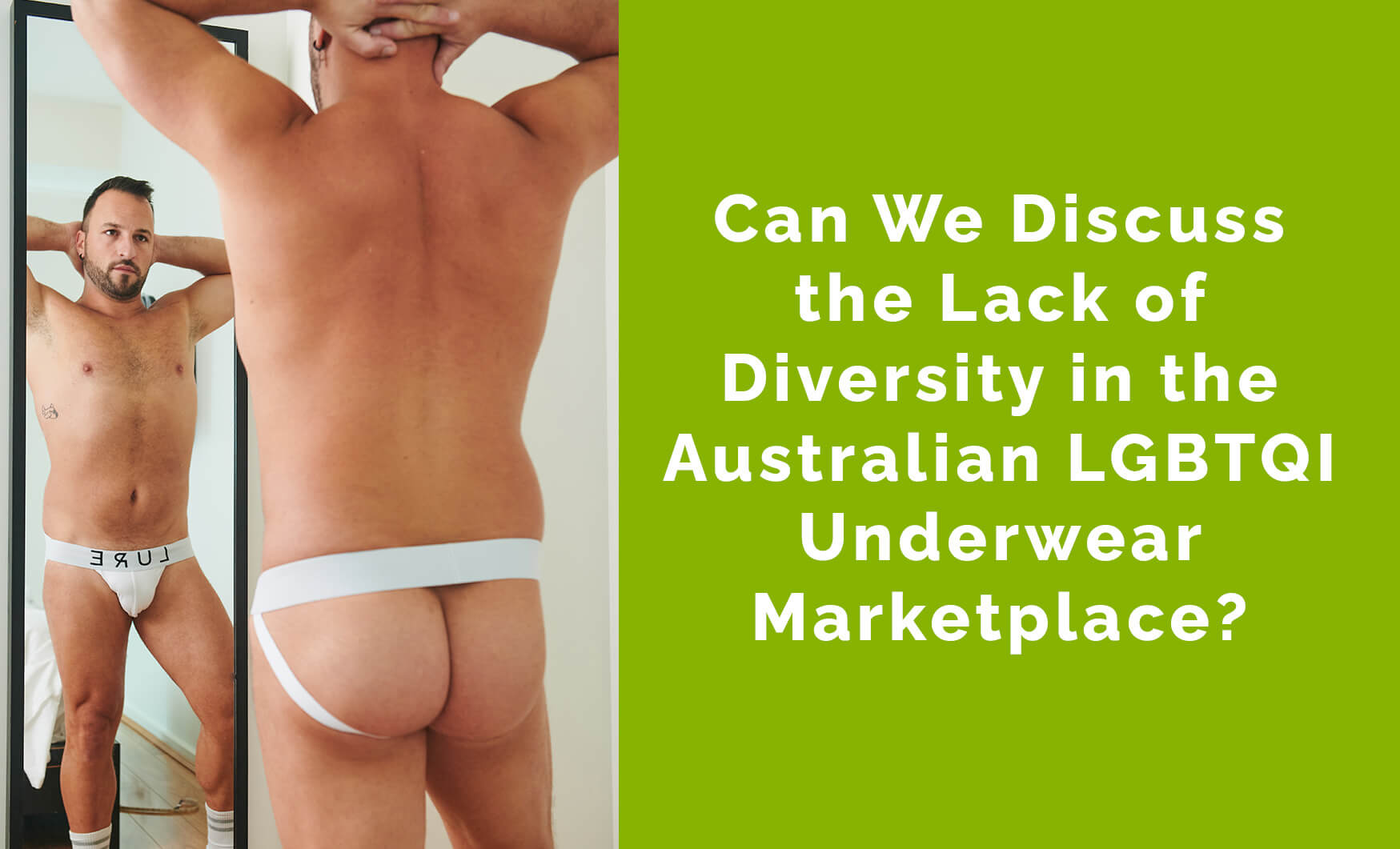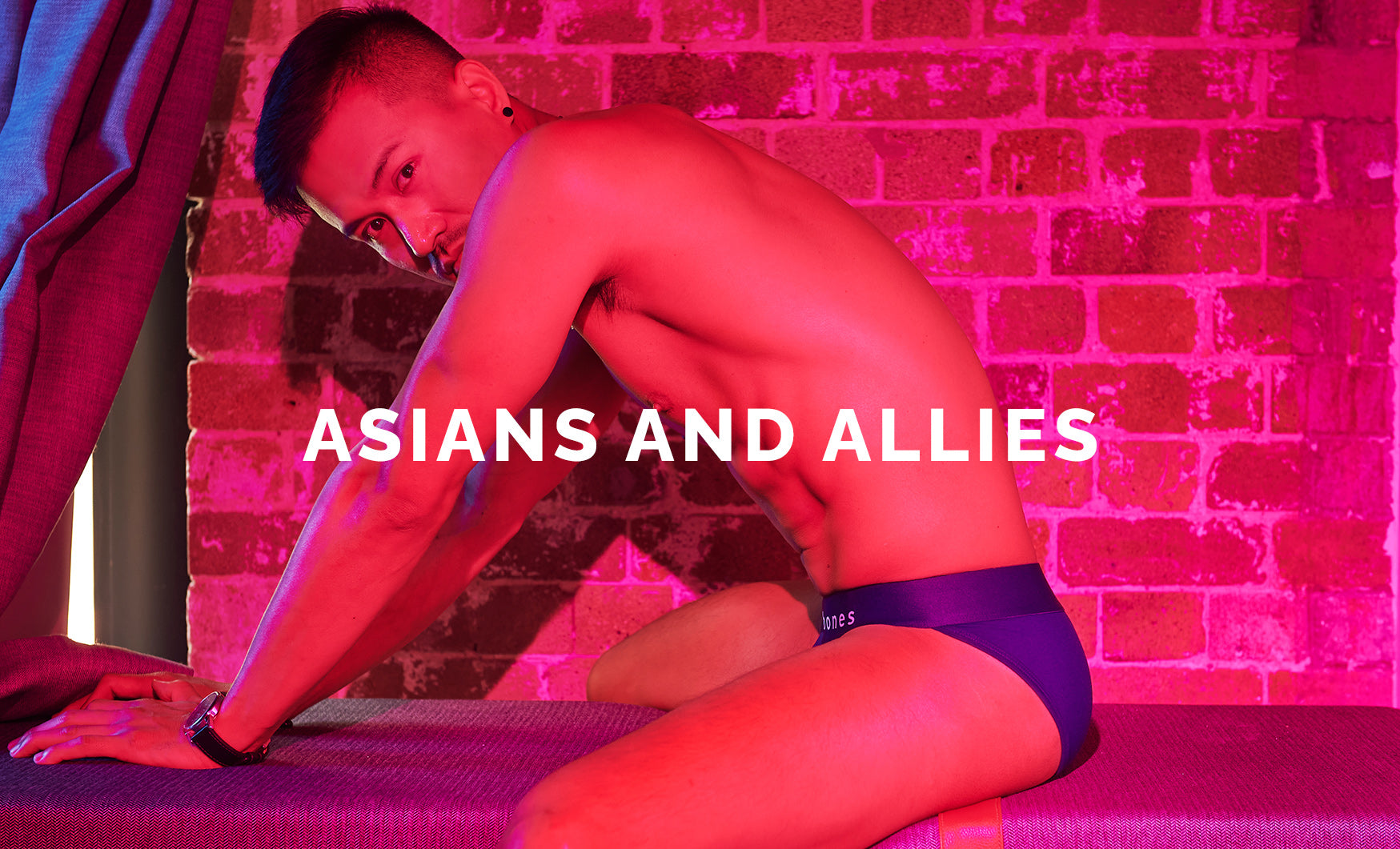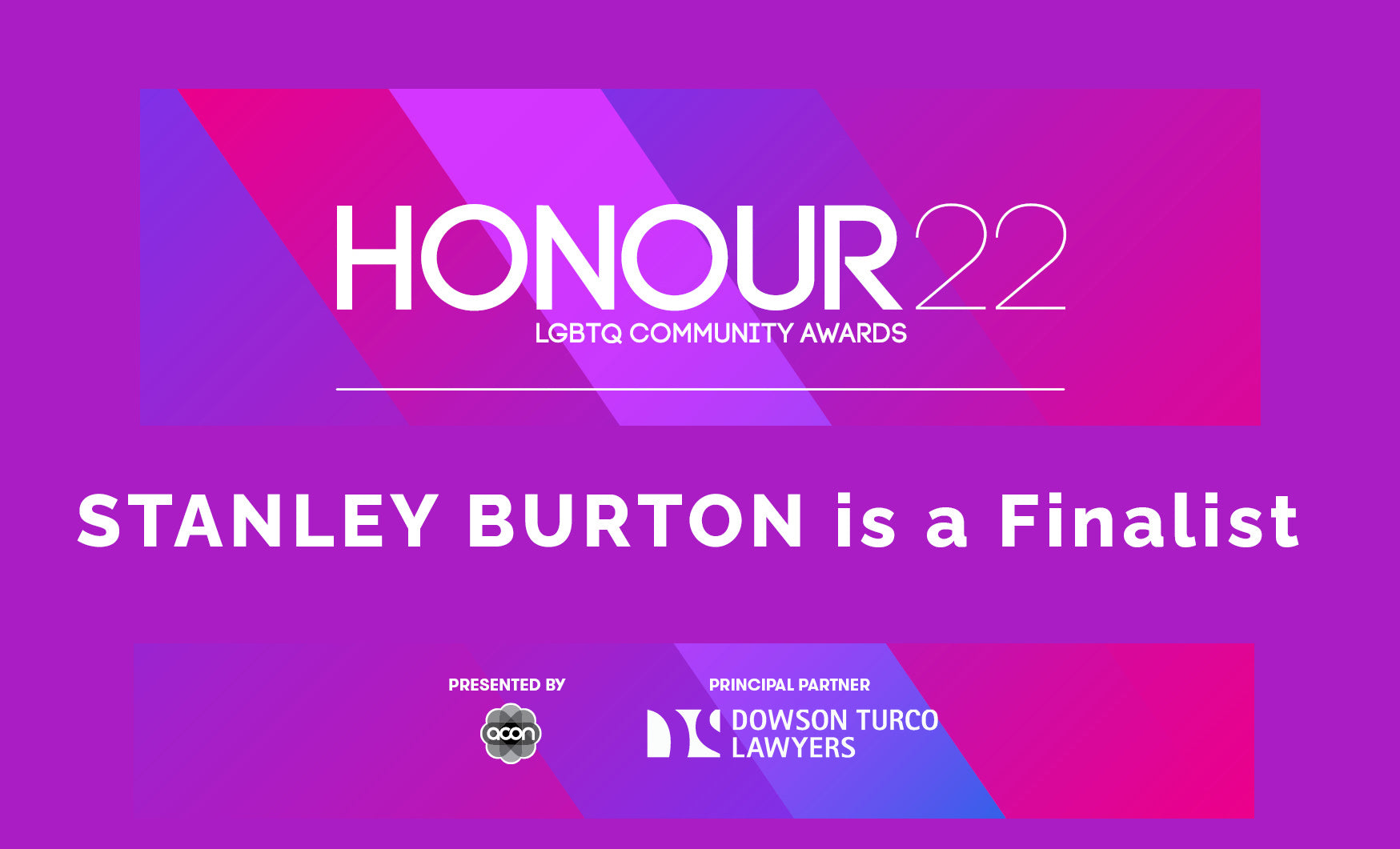Can We Discuss the Lack of Diversity in the Australian LGBTQI Underwear Marketplace?

Social Inclusion is what the Australian LGBTQI Underwear Marketplace Needs Right Now.
Diversity and inclusion empowerment are our native core values when we founded Stanley Burton in 2020 in response to the lack of diversity in the LGBTQI underwear marketplace in Australia. We saw a huge gap in the marketplace that needs to be filled for men to feel confident while embracing their own individualities, owning their identities and loving their appearances. The mainstream underwear brands and retailers have been actively empowering the consumers for over 5 years. But what have the underwear businesses in Australia’s LGBTQI community been doing so far? It seems like a fairly easy question to answer but put it bluntly, our community is far from inclusive. There are signs all over the internet, forums, Facebook groups and social media, if businesses start paying more attention to customers’ feedback, then they can recognise the great divide and unappreciation for people who are different.

Davis wears size medium
Photo by ed from Stanley Burton // Melbourne
Gay men with ripped bodies and glistening abs have been the standard for most LGBTQI fashion brands and retailers in the past 20 years. When I lived in Sydney in the early 2000s, I used to walk down Oxford Street and the shop AussieBoys was one of the first underwear and apparel stores that everyone knew. Shop front had human size posters of white men dominating their windows. Over the years it has remained the same, their marketing strategies have not changed, still aiming for a small portion of the Sydney gay community while abandoning the rest. These images are from brands such as AussieBum which caters for one type of men, 20 something, beach look, with abs. In the real world, I have seen guys with various body types and racial backgrounds wearing the brand, however they are never represented in the advertising. The brand is still using the same type of images across the brand 20 years on.
Then over the last 10 years few other underwear stores have popped up, they are often referred as "always too white" in reference to their advertising. These retailers use overlapping images for ads you can never tell the difference from one store to the next. Their versions of perfection have left the majority of the community feeling inadequate so guys often feel left out when they are not represented. For some, it reminds them of high school when they were picked last in the basketball team - Definitely triggering. These stores have blood all over their hands that contributes to mental health issues across the community.

Jay wears size XL
Photo by ed from Stanley Burton // Melbourne
How can brands be inclusive?
In a nutshell, a fashion brand produces and designs products which often involve a team consisting of fashion designer, business owner and marketing. They have a set guidelines for their ideal demographic which affects the way they market their products. For example, if an underwear brand designs their underwear with bodybuilders in mind, their campaigns follow the brand guidelines referencing the bodybuilding community - talents, concepts, brand anchors, ideas, slogans and visuals. They may also produce less size offerings, because bodybuilders don’t often have waists larger than 32”. A brand is seen as unrealistic with tunnel vision, disconnecting from the wider community and neglecting the majority of men who don’t have bodybuilder physique but can also wear their underwear. This is not being inclusive. When a person with a 35” waist searches on Google for men’s underwear, the result comes back with this underwear brand that features a whole page of bodybuilders. He feels inadequate because he does not look like any of the guys on the website.
This still exists in Australia especially in the LGBTQI community, a lot of mainstream brands have shifted their marketing strategies to embrace inclusion and consumers have made the right choice for trusting brands to do the right thing. However, in the LGBTQI community, underwear brands have been popping up online everywhere in the past few years. I often get confused with these brands because they all use the same type of men to be the face of the brand, recycling other similar brand’s ideas with the same faces and similar style of photography - mind you they probably use the same few photographers. The people behind these brands are often influencers who don’t have any experiences with e-commerce and marketing or some of these businesses have been around for a long time so they don’t feel the need to change their strategies but believe that ‘the new customers will come because we are popular’.
The gay market is fairly small in Australia with only a handful of underwear brands in the competitive market. Gay guys love getting validation from brands and social media and always feel the need to gain a brands’ approvals. News flash!! You don’t owe them anything, you DO NOT need anyone's approval for your bodies. Guys need to have more self respect, because you are the only one who should approve of your own bodies. Words of advice and this goes beyond social media, you should not sell yourself short to get someone's attention, if they chose not to include you in their social media platform you're not the problem. These brands that produce their own versions of perfection are the contributing factor for the rise in mental health issues in the LGBTQI community. You certainly don’t need our approvals at Stanley Burton because we treat everyone equally. No judgement. No preferences.

Davis wears size medium
Photo by ed from Stanley Burton // Melbourne
How can retailers empower the community with inclusion?
Over the last 2 decades I have worked at the majority of the top 5 online retailers in Australia as a photographer and also in creative management with decision making power - Peter’s of Kensington, OO.com.au, GraysOnline and Catch.com.au just to name a few. I have had the opportunities to moderate all contents before they go to market while making changes along the way to best represent the morality of the online store.
In 2019 when I was the post production manager at Catch, I was asked by the Head of Creative to Photoshop the tattoos off a female model for a streetwear campaign. I argued that ‘If you remove her tattoo then you are not truly allowing people to express themselves, it is her body. You had a choice of not selecting this model if it did not suit your campaign. Now it seems like a bad decision to manipulate her appearances to suit your campaign” The model’s tattoo stayed on, the clothes sold like hot pies.
Therefore being inclusive means a business should include a diverse group of decision makers in the management team, such as people of colour, age, gender, ethnicity, sexual orientation and education. Retailers are not solely dependent on brands, because once they purchase the stock they have the freedom to market for their own customers. For example Myer and K Mart may sell the same underwear brand but they target different demographics so the retailers need to make their own decisions as to the type of visuals that goes to market. Unless brands have specific guidelines on how their products and branding should be presented, then the retailers need to comply with the specifications.
Suppliers and fashion labels supply marketing assets, which the retailers can choose to use or self commission. Most retailers like Catch or The Iconic would self commission for product listing and campaigns, but also use supplier images when appropriate. Brands may only photograph one style for illustrative purposes but the retailers ensure all styles and colours are featured on the product listing page to avoid confusion or product returns from customers. They use agency represented talents based on their own guidelines, if any would come from the photography / content department as to what appears on their websites. Large retailers in the conventional market often have no particular guidelines, as they use a diverse range of talents - skin colour, body size and age groups. Catch belongs to the mainstream market and is NOT owned or managed by LGBTQ people, but they are indeed inclusive.
Retailers should be using their sales channels as a platform to influence their customers and the wider community through marketing and partnership with not-for-profit (NFP) organisations for causes that matter to them. They can use different formats to influence their customers, such as communication, engagement through social media, starting a conversation through in public forums or by donating to an appropriate cause. Last year we were involved with Thorne Harbour Health for contributing to the cause for People Living with HIV to bring awareness about the stigma still happening in our community.
How is Stanley Burton Making a Change?
Change is about progress, it cannot be done in one go, it needs to be done with sensitivity and dignity. Since diversity and inclusion is in our blood, we have no need to change or rebrand. With change, we are also creating opportunities for guys to be seen and heard. We work with a number of brand champs to champion our branding to the wider community.
We use photos and videos supplied by the underwear brands. We also self commission or act as a producer by hiring photographers such as BAM from Tokyo to photograph Asian representation concepts. Since we stock mostly international brands we feel the need to have more Australian lifestyle involving real people from our community so we also shoot our own photos which are featured throughout our social media, online store and publishing partners DNA Magazine to promote cultural diversity in Australia. Our captions on Instagram are always informative, empowering and educational. We use the social media platform to promote change and empowerment.

Daiki wears size small
Photo by BAM // Tokyo
We are committed to social responsibilities.
We are made up of two Asians in the LGBTQI community and we are the people that we advocate and empower.
We have been discriminated against by the community as individuals because of our skin colour, age and body types.
We make conscious decisions based on values and what we have witnessed in the LGBTQI community, we pay attention and address the issues with dignity.
We set a standard for the LGBTQI underwear industry.
We partner with businesses and organisations that can get our message across the wider community.
Our diversity and inclusion movement has influenced Dailyjocks, a staple for gay guys in the community when they saw our November 2021 Cultural diversity campaign at our publishing partner DNA Magazine with our first campaign for empowering Asian Representation in underwear ads they decided to rebrand. We have disrupted the underwear market place for being inclusive and we pride ourselves on being the first LGBTQI underwear business in Australia to take real and authentic actions by empowering cultural diversity, age inclusion and body positivity.
Most importantly, we stock underwear brands that advocate for change for the community.
LURE ‘Socially Inclusive’ Underwear Brand
Early 2021, Burton was sourcing brands who empower inclusion and he stumbled upon Lure Menswear, based in the UK. Lure unapologetically spells out ‘socially inclusive’ in their bio, which caught our attention. Rarely do we see brands in Australia participate in something so brilliant, mostly brands include the standard diversity and inclusion statement copied from another website. Also the photos shot by Lure’s team include vastly diverse bodies and looks which is inconsistent with the other underwear brands who produce polished, highly retouched unrealistic models. Lure pays attention to the customers, indeed their market research and attention to their demographics pays off, and our own customers have responded well with Lure.
This month, we feature LURE as our brand focus, below is an empowering interview with the director from Lure. He talks about the journey so far for Lure and elaborates upon the definition of their core value being 'social inclusive'.
Define 'socially inclusive'. What does it mean for Lure to be more inclusive than other brands on the market?
Our understanding of this is that we comment and like as many customer images as we can. Whenever a customer tags us in a post or shares to their social media, we re-post every single one, no matter the size/body shape etc of the individual. This is truly socially inclusive as no matter who you are, if you’re in our underwear, we want you to feel empowered and confident.

Alex wears size medium
Photo by Lure's team // UK
Did you target locally first, because you know your landscape more..
Yes, the first 6 months were all about making a hit on the UK scene before we looked further afield. To Be honest, Stanley Burton was our first overseas venture and since then we’ve worked with others in Spain and the USA to try to reach the LGBTQ+ community and give them Lure’s vision.
Lure Underwear setting a standard for ‘diversity and inclusivity’ is a big mission. How was your response in the beginning?
I feel we’ve had a positive response from the comments and feedback on social media, we’re always conscious to showcase as many body types as possible & we did get some criticism in the beginning “if we were diverse, why do we not showcase individuals from the Asian, black community etc”, however, truthfully, we find it difficult to entice that community, we recently pro-actively reached out to 50+ individuals to see if they would want to collab, however only got 1 reply (lack of confidence being the main reason they didn’t want to participate).Since there are already a lot of underwear brands around, how did you grab the public’s attention?
We tried to be as engaging as possible on social media and truly interacting with our followers. We believe that it’s crucial to be as involved with our community as possible and feel that we have built up an organic following that is gradually increasing. We also looked beyond the “norm” and worked with FTM collaborators etc.
Do you respond to people who want a wide range of sizes? And why do you think underwear industry for the gays have been only offering a limited size range?
Yes, we initially launched XS – XL sizes, which is typically the norm. Customers did ask for larger sizes and we struggled to add this to our collection in the early days due to the order quantities required and unsure if they would sell etc. However we did launch 2XL and 3XL sizes as soon as we could, just within our best selling colours etc to “test” how it would go.
After a slow start, we did focus heavily on marketing these larger sizes and now our new collection features our biggest range of sizes ever.

People like to see themselves being represented when they shop online. ‘His body is like mine, I’d buy that!’ said one of Stanley Burton’s customers when he saw Lure underwear on our online store. ‘I am the same build like this model in jockstrap. I would look great in that.’ said another. At Stanley Burton, we create a safe space for the Australian LGBTQI community to shop and a place where they can feel comfortable in their own skin. That’s confidence!
Feeling empowered by our social movement? Confident is sexy in Lure Underwear. Shop the collection below.



